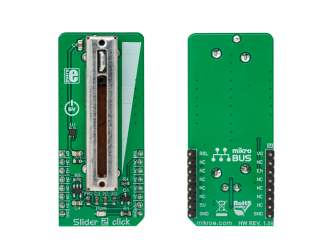
We strongly encourage users to use Package manager for sharing their code on Libstock website, because it boosts your efficiency and leaves the end user with no room for error. [more info]

Rating:
Author: MIKROE
Last Updated: 2018-12-28
Package Version: 1.0.0.0
mikroSDK Library: 1.0.0.0
Category: ADC
Downloaded: 5587 times
Not followed.
License: MIT license
The Slider 2 click is a very accurate potentiometer Click Board, featuring a high-quality mechanical slide-action potentiometer (slider), which in conjunction with the accurate voltage reference IC, provides very precise analog control voltage (CV) at its output.
Do you want to subscribe in order to receive notifications regarding "Slider 2 click" changes.
Do you want to unsubscribe in order to stop receiving notifications regarding "Slider 2 click" changes.
Do you want to report abuse regarding "Slider 2 click".


Library Description
The library contains functions to enable or disable the chip and sets the maximum output voltage reference.
Key functions:
void slider2_enable(uint8_t state) - Function for enabling or disabling devicevoid slider2_setReference(uint8_t ref) - Function for setting max output voltage
void applicationTask()
{
sliderValue = ADC1_Read(4);
WordToHex(sliderValue, demoText);
mikrobus_logWrite(" Slider value : 0x", _LOG_TEXT);
mikrobus_logWrite(demoText, _LOG_LINE);
Delay_ms( 500 );
}
Other mikroE Libraries used in the example:
ADCAdditional notes and information
Depending on the development board you are using, you may need USB UART click, USB UART 2 click or RS232 click to connect to your PC, for development systems with no UART to USB interface available on the board. The terminal available in all MikroElektronika compilers, or any other terminal application of your choice, can be used to read the message.